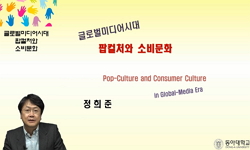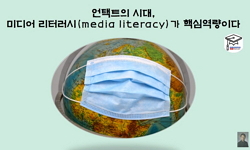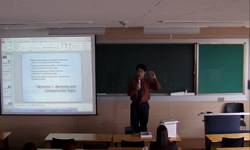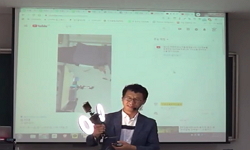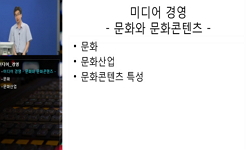Baz Luhrmann’s radical film William Shakespeare’s Romeo+Juliet (1996) offers a stunning contemporary vision of Shakespearean play text. Luhrmann uses a variety of media forms and images from consumer culture to create very popular filmic productio...
http://chineseinput.net/에서 pinyin(병음)방식으로 중국어를 변환할 수 있습니다.
변환된 중국어를 복사하여 사용하시면 됩니다.
- 中文 을 입력하시려면 zhongwen을 입력하시고 space를누르시면됩니다.
- 北京 을 입력하시려면 beijing을 입력하시고 space를 누르시면 됩니다.

<윌리엄 셰익스피어의 로미오+줄리엣>의 미디어와 소비문화 = Media and Consumer Culture in Baz Luhrmann’s William Shakespeare’s Romeo+Juliet
한글로보기부가정보
다국어 초록 (Multilingual Abstract)
Baz Luhrmann’s radical film William Shakespeare’s Romeo+Juliet (1996) offers a stunning contemporary vision of Shakespearean play text. Luhrmann uses a variety of media forms and images from consumer culture to create very popular filmic productions, addressed to an up-to-date modern mass audience.
William Shakespeare’s Romeo+Juliet seems like a good example of post-modern pastiche, which puts together a plethora of allusions, copies, and intertextuality (the western movie, the gangster movie, the kung-fu pic, the urban thriller, crime-thriller, the action comedy, MTV, etc). He borrows the characteristics of many genres and styles and re-works these elements through his signature “Bazmark” style to make postmodern pastiche, in which the distinction between high and low art is collapsed and everything has equal value.
In Luhrmann’s film, Shakespeare’s language becomes the source of advertising copy and a brand name. And the film, where sacred and profane exist in a dynamic balance, is so saturated with religious symbolism, that is intimately mingled with consumer culture. The mockery of a religion plays a clashing role in Luhrmann’s mise-en-scène, for the giant statues of Christ, Mary, and various saints compose a powerless group of silent onlookers to the violence in Verona, and for the film portrays religion as a media icon or a brand name or a just another commodity in post-modern consumer culture.
To mix popular culture with elements of high culture, Luhrmann opens his film with a television news report that functions as the classical chorus, followed by the hasty progression of newspaper headlines concerning the “new mutiny” and “ancient grudge” between Capulets and Montagues. But Jean Baudrillard claimed that everything today is composed of simulacra of previously existing things. According to Baudrillard’s theory, the news on television is the hyperreal, though it seems to refer to something real; the news is a simulation designed to hold the attention of the viewer. In the circular frame where everything begins and ends with television news, the whole tragedy of Romeo and Juliet is presented as an event within the TV news.
Luhrmann’s film can be read as a canonical example of iconoclasm, for it challenges to the Shakespearean canon and timeless, eternal values he represents. Though Luhrmann may try to make Shakespeare relevant to today’s society from a new contemporary innovative viewpoint, the practice of this film consequently seems to cast a doubt on Shakespearean icon of literary value and to destabilize the previously unshakeable stability of his authority. Luhrmann’s flamboyant cinematographic style, “Bazmark,” has positioned him as an innovative, creative auteur competing with High Culture Shakespeare within the domain of contemporary cultural milieu.
다국어 초록 (Multilingual Abstract)
Baz Luhrmann’s radical film William Shakespeare’s Romeo+Juliet (1996) offers a stunning contemporary vision of Shakespearean play text. Luhrmann uses a variety of media forms and images from consumer culture to create very popular filmic productio...
Baz Luhrmann’s radical film William Shakespeare’s Romeo+Juliet (1996) offers a stunning contemporary vision of Shakespearean play text. Luhrmann uses a variety of media forms and images from consumer culture to create very popular filmic productions, addressed t o an up-to-date modern mass audience.William Shakespeare’s Romeo+Juliet seems like a good example of post-modern pastiche, which puts together a plethora of allusions, copies, and intertextuality (the western movie, the gangster movie, the kung-fu pic, the urban thriller, crime-thriller, the action comedy, MTV, etc). He borrows the characteristics of many genres and styles and re-works these elements through his signature “Bazmark” style to make postmodern pastiche, in which the distinction between high and low art is collapsed and everything has equal value.
In Luhrmann’s film, Shakespeare’s language becomes the source of advertising copy and a brand name. And the film, where sacred and profane exist in a dynamic balance, is so saturated with religious symbolism, that is intimately mingled with consumer culture. The mockery of a religion plays a clashing role in Luhrmann’s mise-en-scène, for the giant statues of Christ, Mary, and various saints compose a powerless group of silent onlookers to the violence in Verona, and for the film portrays religion as a media icon or a brand name or a just another commodity in post-modern consumer culture.
To mix popular culture with elements of high culture, Luhrmann opens his film with a television news report that functions as the classical chorus, followed by the hasty progression of newspaper headlines concerning the “new mutiny” and “ancient grudge” between Capulets and Montagues. But Jean Baudrillard claimed that everything today is composed of simulacra of previously existing things. According to Baudrillard’s theory, the news on television is the hyperreal, though it seems to refer to something real; the news is a simulation designed to hold the attention of the viewer. In the circular frame where everything begins and ends with television news, the whole tragedy of Romeo and Juliet is presented as an event within the TV news.
Luhrmann’s film can be read as a canonical example of iconoclasm, for it challenges to the Shakespearean canon and timeless, eternal values he represents. Though Luhrmann may try to make Shakespeare relevant to today’s society from a new contemporary innovative viewpoint, the practice of this film consequently seems to cast a doubt on Shakespearean icon of literary value and to destabilize the previously unshakeable stability of his authority. Luhrmann’s flamboyant cinematographic style, “Bazmark,” has positioned him as an innovative, creative auteur competing with High Culture Shakespeare within the domain of contemporary cultural milieu.
참고문헌 (Reference)
1 Maslin, Janet, "William Shakespeare’s Romeo+and Juliet Review"
2 Luhrmann, Baz, dir, "William Shakespeare’s Romeo and Juliet"
3 Matthews, Peter, "William Shakespeare’s Romeo and Juliet" 7 (7): 54-55, 1997
4 Phillips, John, "To be or not to be Postmodern: Shakespeare and Postmodernism"
5 Rutter, Carol Chillington, "The Cambridge Companion to Shakespeare on Film" Cambridge UP 241-260, 2000
6 Hindle, Maurice, "Studying Shakespeare On Film" Palgrave Macmillan 2007
7 Debord Guy, "Society of the Spectacle" Zone Books 1994
8 Coursen, Herbert R, "Shakespeare: The Two Traditions" AUP 1999
9 Anderegg, Michael, "Shakespeare, The Movie, II: Popularizing the Plays on Film, TV, Video, and DVD" Routledge 56-71, 2003
10 Loehlin, James N, "Shakespeare, Film, Fin de Siècle" St. Martin’s 121-136, 2000
1 Maslin, Janet, "William Shakespeare’s Romeo+and Juliet Review"
2 Luhrmann, Baz, dir, "William Shakespeare’s Romeo and Juliet"
3 Matthews, Peter, "William Shakespeare’s Romeo and Juliet" 7 (7): 54-55, 1997
4 Phillips, John, "To be or not to be Postmodern: Shakespeare and Postmodernism"
5 Rutter, Carol Chillington, "The Cambridge Companion to Shakespeare on Film" Cambridge UP 241-260, 2000
6 Hindle, Maurice, "Studying Shakespeare On Film" Palgrave Macmillan 2007
7 Debord Guy, "Society of the Spectacle" Zone Books 1994
8 Coursen, Herbert R, "Shakespeare: The Two Traditions" AUP 1999
9 Anderegg, Michael, "Shakespeare, The Movie, II: Popularizing the Plays on Film, TV, Video, and DVD" Routledge 56-71, 2003
10 Loehlin, James N, "Shakespeare, Film, Fin de Siècle" St. Martin’s 121-136, 2000
11 Buchanan, Judith, "Shakespeare on Film. Essex" Pearson Education 2005
12 Donaldson, Peter S, "Shakespeare after Mass Media" Palgrave 59-82, 2002
13 Baudrillard, Jean, "Selected Writings" Polity 1988
14 Hodgdon, Barbara, "Romeo and Juliet" Palgrave 126-146, 2001
15 Cartmell, Deborah, "Reading and Screening Ophelia: 1948-1966" 8 : 28-41, 1997
16 Walker, Elsie, "Pop Goes the Shakespeare: Baz Luhrmann’s William Shakespeare’s Romeo+Juliet" 28 (28): 132-139, 2000
17 Arroyo, José, "Kiss Kiss Bang Bang" 7 (7): 6-9, 1997
18 Featherstone, Mike, "Consumer Culture and Postmodernism" Sage 1991
19 Hamilton, Lucy, "Baz vs. The Bardolaters, Or Why William Shakespeare’s Romeo+Juliet Deserves Another Look" 28 (28): 118-124, 2000
20 Walker, Elsie, "A ‘Harsh World’ of Soundbite Shakespeare: Michael Almereyda’s Hamlet (2000)"
21 Rothwell, Kenneth S, "A History of Shakespeare on Screen: A Century of Film and Television" Cambridge UP 1999
동일학술지(권/호) 다른 논문
-
『마저리 켐프 서』에 나타난 “피조물”: 예화적 자기지칭어
- 한국중세근세영문학회
- 이희구
- 2014
- KCI등재
-
Seeing as Believing: Beholding the Image in Lydgate’s Life of Our Lady
- 한국중세근세영문학회
- 박환희
- 2014
- KCI등재
-
- 한국중세근세영문학회
- 윤주옥
- 2014
- KCI등재
-
- 한국중세근세영문학회
- 김현주
- 2014
- KCI등재
분석정보
인용정보 인용지수 설명보기
학술지 이력
| 연월일 | 이력구분 | 이력상세 | 등재구분 |
|---|---|---|---|
| 2018 | 평가예정 | 계속평가 신청대상 (등재유지) | |
| 2015-01-01 | 평가 | 등재학술지 유지 (등재유지) |  |
| 2011-01-01 | 평가 | 등재학술지 유지 (등재유지) |  |
| 2009-01-01 | 평가 | 등재학술지 유지 (등재유지) |  |
| 2007-04-24 | 학회명변경 | 한글명 : 고전 르네상스 영문학회 -> 한국 고전 르네상스 영문학회 |  |
| 2006-07-03 | 학회명변경 | 한글명 : 고전 르네상스영문학회 -> 고전 르네상스 영문학회 |  |
| 2006-01-01 | 평가 | 등재학술지 선정 (등재후보2차) |  |
| 2003-01-01 | 평가 | 등재후보 1차 PASS (등재후보1차) |  |
| 2003-01-01 | 평가 | 등재후보학술지 선정 (신규평가) |  |
학술지 인용정보
| 기준연도 | WOS-KCI 통합IF(2년) | KCIF(2년) | KCIF(3년) |
|---|---|---|---|
| 2016 | 0.22 | 0.22 | 0.22 |
| KCIF(4년) | KCIF(5년) | 중심성지수(3년) | 즉시성지수 |
| 0.19 | 0.15 | 1.112 | 0 |




 KCI
KCI